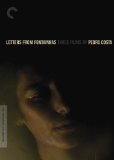| Reviews & Columns |
|
Reviews DVD TV on DVD Blu-ray 4K UHD International DVDs In Theaters Reviews by Studio Video Games Features Collector Series DVDs Easter Egg Database Interviews DVD Talk Radio Feature Articles Columns Anime Talk DVD Savant Horror DVDs The M.O.D. Squad Art House HD Talk Silent DVD
|
DVD Talk Forum |
|
|
| Resources |
|
DVD Price Search Customer Service #'s RCE Info Links |
|
Columns
|
|
|
Letters from Fontainhas: Three Films by Pedro Costa
THE MOVIES:
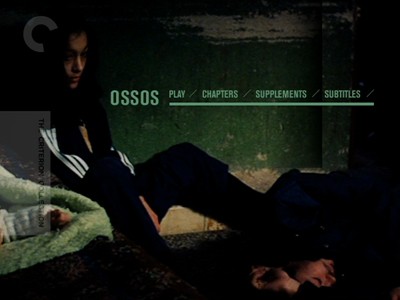
Portuguese filmmaker Pedro Costa is a bit of a difficult puzzle, and those entering his new boxed set cold (such as I did), may find themselves a bit lost at the outset. The Criterion Collection's bundling of Letters from Fontainhas: Three Films by Pedro Costa brings together three films made between 1997 and 2006: Ossos (Bones), In Vanda's Room, and Colossal Youth. These ponderous, ethereal films show realistic portrayals of the denizens of the Fontainhas slums in Lisbon, ultimately letting us peek around corners we might not otherwise see or even consider looking into; yet, the films also leave a queasy ambiguity in their wake.
The stark aesthetic style of the lead film, Ossos (1997; 97 minutes), doesn't pretty-up the rundown neighborhood or the people who wander its streets in search of food, money, and human connection. Costa's script has zero exposition and barely any dialogue. Costa demands his viewer fill in the gaps when his characters fail to share their feelings or explain about themselves. The story centers around a baby born to Tina (Maria Lipkina), a suicidal teen who tries to gas herself and the infant shortly after its birth. The homeless father (Nuno Vaz) takes the child from her, but when the kid gets sick, he nearly loses him. A nurse named Eduarda (Isabel Ruth) tries to help, but she is soon victimized by the father's selfish silence. He threatens without speaking, acting on his own impulses with little regard for the child, the mother, or any of the women he touches. Only a whore (Ines Medeiros) whom the thug tries to sell the baby to tells him the truth, that she can't stand him.
Mixed up in this is Clotilde (Vanda Duarte), a neighbor of Tina's who works as a maid and seems to be interested in helping, but her meddling only causes trouble and she doesn't really take care of her own kids, either. The relationship between all of these characters is often hard to figure out. What exactly do they mean to one another? Is it just the proximity and the shared experience that binds them? Costa doesn't seem interested in tying these things together, and though it may cause frustration and confusion when you're watching the film, it ultimately proves unnecessary. Ossos is a series of quiet vignettes strung end to end more than it is a structured narrative, with many of the scenes done in long takes and wavering somewhere between improvisation and Bresson-like construction. As the film comes to its close, the wordless exchanges in the narrow alleys outside of Tina's home suggest a cycle of doom that will never be broken. Just as the baby gets passed from one caretaker to another, or the kids trade Eduarda's compassion as if it were theirs to give, so too is life easily bartered with. In terms of survival, anything goes. Whatever gets you through the day, putting food in your mouth or numbing the pain, it's all negotiable.
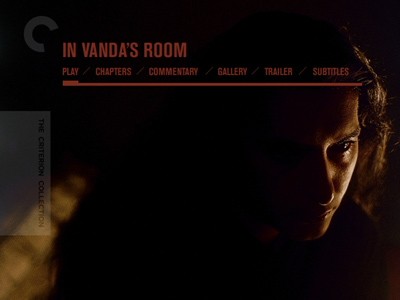
Ossos is slow-going and it requires effort, and I warn you, it doesn't get any easier from there. In the second film in Letters from Fontainhas, In Vanda's Room (2000; 171 minutes), there is a character who, throughout the movie, is trying to untangle a skein of yarn and has little luck. Many may feel the same way watching the film.
Pedro Costa's approach in In Vanda's Room is to get as reductionist as possible, somewhat paradoxically given the length of the film. He shot the movie alone on digital video, blending documentary into a kind of fictional structure by observing his subjects and then arranging his film from over 180 hours of footage. The Vanda of the title is Vanda Duarte, one of the neighborhood girls Costa hired for Ossos, and she quite literally has invited him into her room. He shot there for six months, watching Vanda and her sister Zita freebase smack, before moving over to another house where a group of male addicts were living. There is little by way of narrative construction here, the only central conflict is that the Portuguese government was demolishing the Fontainhas slums while Costa was shooting. The sound of destructive machines is a near constant throughout In Vanda's Room, but our actually seeing the work is rare. In Vanda's Room is all about what is going on inside, not the external stimuli that causes the retreat into a dark room and the hazy smoke of narcotics.
Not much happens here in a conventional sense. Most of the movie features the characters in conversation, sparking up or waiting to spark up. The most action we see comes from nervous habits--Vanda scraping at the phone book, the boys "cleaning up" their home. Costa stands back and listens, and he captures many stories about what is going on in the barrio--there are robberies, deaths, arrests--but again, these all happen outside. In Vanda's Room makes an intimate whisper of the poverty and despair. It leaves us to wonder exactly what we are supposed to feel. Is Costa looking to elicit sympathy? Empathy? Am I wrong for being judgmental? I was sick of listening to Vanda and Zita by the end, sick of their pointless stories and angry outbursts, nauseous watching their bodies deteriorate and listening to Vanda's foul coughing. The boys are falling apart, as well, but we never get to know them in the same way. Should we even be watching this? I feel like an accomplice to ghetto tourism.
The closest Costa brings us to reflection or exposition are scenes when neighborhood men enter Vanda's room. One sits on her bed holding a bouquet of flowers, looking like somebody's grotesque idea of a suitor, talking about his past addictions and his health problems, and seemingly not self-aware enough to admit current addictions. Another gets philosophical with Vanda. She concludes that the lives they have are the ones they chose. Her most poetic utterance, though, comes at the start of their stoned chat, when she assures him, "I'm not sleeping, I'm listening." In other words, she is not blind to her own situation, she is merely awaiting the moment when she must do something about it. The demolition we hear will eventually get to her door and Vanda will have to leave. Fontainhas and its citizens are decaying as one.
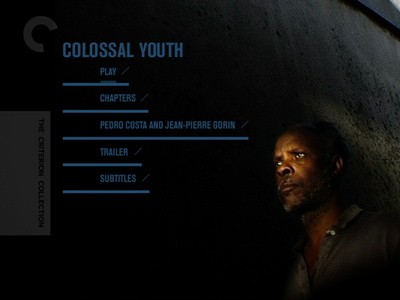
The DV allows Costa to get right in the thick of real life. With no crew encumbering him, with no equipment limiting his space, he can actually shoot inside Vanda's bedroom or from a vantage point down the alley or in a dark crack den with only one candle to see by. It also serves him well when the spaces open up, as they do in Colossal Youth (2006; 156 minutes). The third film in the series picks up in the transformed Fontainhas, now an unfamiliar limbo. The relocation efforts have put the people of Fontainhas in newly constructed, sterile tenements. The high-rise apartment buildings reach to the sky, towering over the displaced. Where once they were cramped and buried in their own poverty, they are now small amongst the government's attempts to mask that same poverty. There is also a lot of white--the outer walls, the inner walls--and it makes the people look like stains against the too-clean backdrop.
The change in the slum has served to break up the community at this point. Costa introduces a new character, Ventura, an old man who wanders the streets visiting his many offspring. His wife has left him (we see her wielding a knife on her way out in the very first scene), he no longer has employment, and he doesn't have a place to live. A civic worker keeps visiting with him and showing him apartments, but Ventura demands a bigger space. He wants enough rooms to house all of his children. He can't give a definitive number to his brood. It's a symbolic distinction. Ventura wishes things were the way they had been before everyone was broken apart, gentrified, relocated.
Some of the same people we saw in In Vanda's Room return, including Vanda Duarte. She is now a mother, married, on methadone, and nearly unrecognizable, having aged six years and gained weight. We also see the man she shared the conversation about life with. He has totally cleaned up and is selling furniture. Sadly, we are also informed that Zita has passed away.
The cat's cradle of yarn from Vanda's Room is replaced in Colossal Youth by a love letter Ventura continually dictates to his friend Alberto "Lento" Barros. Lento asked Ventura to write it for him, and Ventura is requiring that Lento memorize it. It's full of flowery language about a reunion and renewed strength. The poetry speaks of a life joined back together and a positive future. It's an exercise in futility, however; even if a coup d'état hadn't cut off the mail, Lento can't write, so he can never put it to paper.
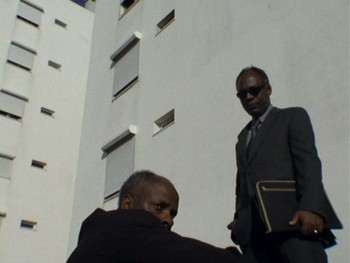
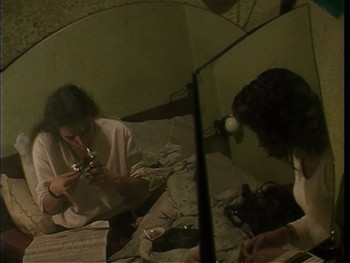
(left to right): Colossal Youth, In Vanda's Room
It's hard to tell if there is hope to be found in the Letters from Fontainhas trilogy. Is survival enough of a happy ending to make these films about the durability of the human spirit rather than wallowing in our most dismal of lows? Writing about In Vanda's Room in the accompanying booklet, Thom Andersen notes that the last sound we hear before the credits roll is laughter. Colossal Youth's penultimate scene shows us a park, the first signs of nature we've seen in any of the films. It's idyllic, sunny, healthy. The last shot shows us Ventura and his granddaughter, the young and the old, the granddad at rest and the child at play. Surely these are meant to give us some belief that regardless of what these people go through or are put through, they will carry on.
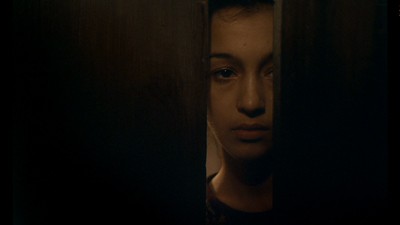
Ossos
THE DVD
Video:
Ossos is the only widescreen film in the collection, and the 1.66:1 transfer is very nice. Though there is some grain, it is a byproduct of the film stock, and it adds to the Neorealism of the piece. The actual print is free from blemish or digital glitches. Both In Vanda's Room and Colossal Youth were shot on digital video at 1.33:1, and the direct port from Costa's original source makes for a clean, crisp DVD image. Vanda has some digital combing, but that appears to be a downside of the early DV.
Sound:
All of the movies are mixed in stereo with a conscientious ear that maintains the realistic soundscape. There is a lot going on in these films in terms of sound, be it construction in the distance or the chirping of birds, and everything is placed properly in the mix.
The optional English subtitles are easy to read and written with a colloquial style befitting the original dialogue.
Extras:
Letters from Fontainhas: Three Films by Pedro Costa is a four-disc set--three DVDs for the movies, the fourth for supplemental features that detail more about Costa. The discs come in their own individual books, with a 44-page booklet being packed in with the bonus DVD. The booklet has photos, credits, and an impressive collection of essential essays about Costa and each of the movies in the trilogy. All the DVD books fit in a side-loading box.
In addition to the DVD 4 supplements, each movie has its own individual features. These are exhaustive and engrossing, opening up the insular world that Costa is depicting. On DVD 1, Ossos, viewers are treated to the following:
* A conversation between Pedro Costa and political filmmaker Jean-Pierre Gorin (33 minutes, 5 seconds) goes in depth into the director's drive to make films and his chosen methods, and where he draws inspiration and meaning. It will set the tone for talks between the two throughout the set.
* Interview with the late critic Joao Benard da Costa (9:19), recorded in 2004.
* Interview with cinematographer Emmanuel Machuel (7:54), also recorded in 2004.
* Video essay by artist Jeff Wall (13 minutes), featuring Wall talking over clips from the movie, analyzing Costa's visual compositions. Wall is a photographer, and so Ossos appeals to him as a story told in images.
* Photo gallery by renowned photographer Mariana Viegas gives us a smattering of black-and-white pics of cast and locations.
DVDs 2 and 3 have less than the first disc. In addition to theatrical trailers for their respective films, the bonuses continue the conversation between Costa and Gorin. On In Vanda's Room it's an in-depth audio commentary that really digs into Costa's intentions and technique; for Colossal Youth, it's another video chat, this time 23-minutes long.
In Vanda's Room has the added bonus of a photo gallery by Richard Dumas.
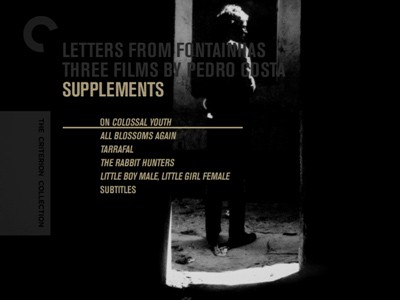
DVD 4 is all supplemental features, and it focuses on material that illuminates Pedro Costa the artist and his mission, including short works the director made that directly relate to the movies contained here.
This disc leads with an audio commentary covering a handful of scenes from Colossal Youth. Running just over 38 minutes, it features critic Cyril Neyrat in discussion with author Jacques Ranciere.
All Blossoms Again is a full-length documentary (1 hour, 20 minutes) on Pedro Costa made by Aurelien Gerbault in 2006. This was shot alongside Colossal Youth and shows the director on set and gives him further forum to talk about the changing face of the slums he has been filming for nearly a decade. Gerbault's style is as distanced and laconic as Costa's, and by showing him at work, meticulously going over scenes, we begin to understand the kind of repetition and endurance required to get after the kind of cinematic art he is creating.
While making Colossal Youth, Costa shot two more short films that came out in 2007. Originally made for an anthology film called The State of the World, Tarrafal (17:43) is a piece that takes place in the wilderness just outside the city, and it is a glimpse of a man (José Alberto Silva) who is being deported back to Cape Verde in Africa. The title refers to the name of a concentration camp that Portugal once had for African prisoners, and a feeling of dread looms over the whole film. There is also a weird nostalgia, a sense that the man's family would like to return to their home, just not under these circumstances. Stories they tell each other illustrate a healthy fear of authority as the bringers of death.
Colossal Youth's star Ventura also appears in Tarrafal, and footage from the same shoot as Tarrafal is reconfigured to show scenes from his point of view in The Rabbit Hunters (23:112) (also made for an anthology film, this one called Memories). This is the first place in the Costa films where an element of mysticism may be inserted into the narrative. Tying it back to the stories of death in the other short, we learn that the deported man's father, who lingers around Tarrafal, may in fact be a spirit that is hanging around with Ventura. Calling him a "ghost" could also be metaphor (there is also a story in Colossal Youth about a man whose funeral is being planned prematurely), but in either case, his preoccupation is with wrongs done to him in life and the confusing circumstances that lead to his current state. The Rabbit Hunters suggests that that the afterlife may be no more a reward than living.
In 2006, Pedro Costa created a museum installation called Little Boy Male, Little Girl Female (34:40). It takes leftover footage from In Vanda's Room and Colossal Youth and creates a split screen where we see an exterior scene side by side with an interior scene (or sometimes just two locales), a kind of extended view of life in Fontainhas as it exists both on the street and behind closed doors. Usually, one side is active while the other is passive. There is no translated dialogue, it just runs with the audio as is. Combined with the two short films and the interlocking narrative those pieces share, the gathered footage forms a sort of commentary on the variables of point of view.
FINAL THOUGHTS:
Recommended. There should almost be some kind of patience test required before you crack open Criterion's Letters from Fontainhas: Three Films by Pedro Costa. If you score high enough, then the three movies contained inside are for you! Costa's reductionist style is like Neorealism to the Nth degree, and his ramshackle narratives are not going to win over a mass audience any time soon. His portraits of the Lisbon slum from which the boxed set takes its name give us a look at poverty and the despair of the dispossessed up close, but there is an inherent distance that suggests we can never fully understand their world unless we live in it. In some ways, I think writing about Costa's movies is actually more interesting than watching them, because things came together for me in the process that I didn't get while I was struggling to get through the movies themselves. The extras included in the set help open up the art, making them essential viewing unto themselves--a rarity in DVD extras these days. If you take the time with Letters from Fontainhas, you will find some reward, you're just going to have to earn it.
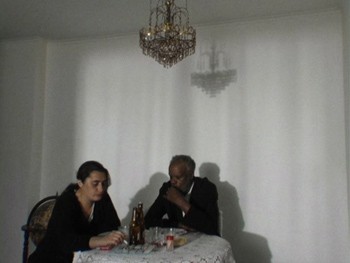
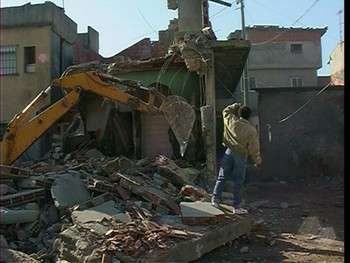
Colossal Youth, In Vanda's Room
Jamie S. Rich is a novelist and comic book writer. He is best known for his collaborations with Joelle Jones, including the hardboiled crime comic book You Have Killed Me, the challenging romance 12 Reasons Why I Love Her, and the 2007 prose novel Have You Seen the Horizon Lately?, for which Jones did the cover. All three were published by Oni Press. His most recent projects include the futuristic romance A Boy and a Girl with Natalie Nourigat; Archer Coe and the Thousand Natural Shocks, a loopy crime tale drawn by Dan Christensen; and the horror miniseries Madame Frankenstein, a collaboration with Megan Levens. Follow Rich's blog at Confessions123.com.
|
| Popular Reviews |
| Sponsored Links |
|
|
| Sponsored Links |
|
|
| Release List | Reviews | Shop | Newsletter | Forum | DVD Giveaways | Blu-Ray | Advertise |
|
Copyright 2024 DVDTalk.com All Rights Reserved. Legal Info, Privacy Policy, Terms of Use,
Manage Preferences,
Your Privacy Choices | |||||||









